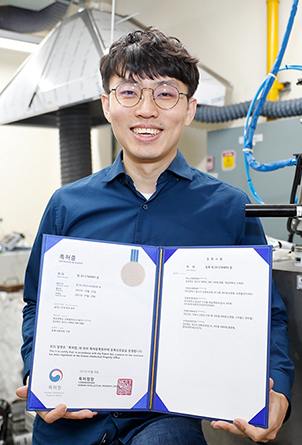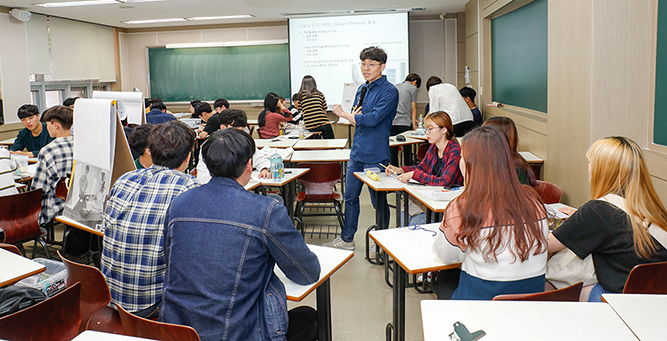School of Materials Science and Engineering Gets Patent with an Idea during an Undergraduate Class N
No.89000- Writer pr
- Date : 2017.10.13 09:39
- Views : 8175
During Professor Park No-geun’s class on ‘Steel Forging (Design Class)’, professor and student came up with an idea
Developed ‘slag measurement’ technology, an old challenge of the steel industry
Pursuing application of equipment at the site through industry-academic research together with POSCO, etc.
[September 25, 2017]
Developed ‘slag measurement’ technology, an old challenge of the steel industry
Pursuing application of equipment at the site through industry-academic research together with POSCO, etc.
[September 25, 2017]

News was made as YU undergraduate students came up with an idea during class that led to a patent being registered with high values for industrial use. This was the fruit reaped after two years of passion and challenges from a professor and students.
The patent registered was ‘Slag Thickness Measurement Device (Patent 10-1764894)’. This was devised during the second semester of 2015 so that the idea that was made during the ‘Steel Forging (Advisor Park No-geun)’, which is a design class for juniors in the School of Materials Science and Engineering, could be applied in industrial sites.
The inventors for the patent are YU Professor of Materials Science and Engineering Park No-geun (36, left on photo), Joo Jae-bin (27) who was a senior at the time, Kim Hyeong-wook (27), Koo Jung-mo (27), and Koo Gwi-young (23) who were sophomores. These students who were undergraduates when the patent was first applied for (October 2015) are not working at metal-related companies, while some enrolled in graduate school.
Joo Jae-bin, who is working at a company specializing in the manufacturing of special steels, said, “As an undergraduate, it was difficult to complete a patent application, complete CAD works, and apply for patents. In particular, the essence for the patent was on improving the process, but it was difficult to gain information on the process, so we had difficulties.” He added, “I think the countless meetings with the professor and students to perfect the idea led to such great results. My experience back then helped me greatly in finding a job specializing in the production of special steels.”
Professor Park said, “The steel forging design class aims at understanding the chemical reactions between processes of steel refineries such as POSCO or Hyundai Steel, and to apply this to design processes or materials that can make it safer and have higher productivity in terms of engineering.” He added, “Applying engineering knowledge to design ideas that can be applied in an actual industrial site, and filling out patent applications as an undergraduate student will be a great asset in carrying out actual work.”

<‘Steel Forging’ class of Professor of Materials Science and Engineering Park No-geun>
It is expected that the patent registered will have significant value for use in actual industries. Slag refers to residue generated during the process of refining steel. Voices on the need to measure the quantity of slag in refineries were made dozens of years ago. But it was practically impossible to measure the amount of slag in high temperature work environments that reached up to 1,500 degrees. Therefore, operations were carried out depending on past experiences.
Professor Park said, “Slag is a liquid ceramic made when oxygen mixes with molten metal. Ceramic materials should not be mixed with steel so it must be removed as much as possible. Therefore, it is very important to measure the slag thickness and volume.” He added, “During class, the students and I decided to apply the idea of measuring the height and volume of beer and foam in a glass to molten metal and slag. Starting with such idea, we resolved the problem occurring when measuring slag thickness at 1,500 degrees using the TRIZ (Theory of Solving Inventive Problems) and developed technologies that could be applied practically, and we were thus able to receive this patent.”
The registered patent can be used by companies with blast furnaces such as POSCO and Hyundai Steel, and small factories with electric furnaces to adjust working conditions by measuring the amount of slag when making molten metal. Because slag and molten metal were discarded together in the past to remove slag, it had the weakness of having low recovery rates of molten metal. Using this patented technology to precisely measure the amount of slag, it will be possible to remove just the necessary amount of slag, and can thus improve the recovery rate of molten metal.
Professor Park said, “Through the support of the YU PRIME program, I have been listening to the needs of industries and have been thinking about designs that could resolve the needs and be applied. This patent will be a ground-breaking technology that can remove slag, which has been an age-old challenge of the steel industry.” He added, “We are currently using this patent to discuss purchase condition development projects through industry-academic research with POSCO and small and medium enterprises in Pohang. We are also doing research to make a prototype for the idea and to apply it in actual facilities.”